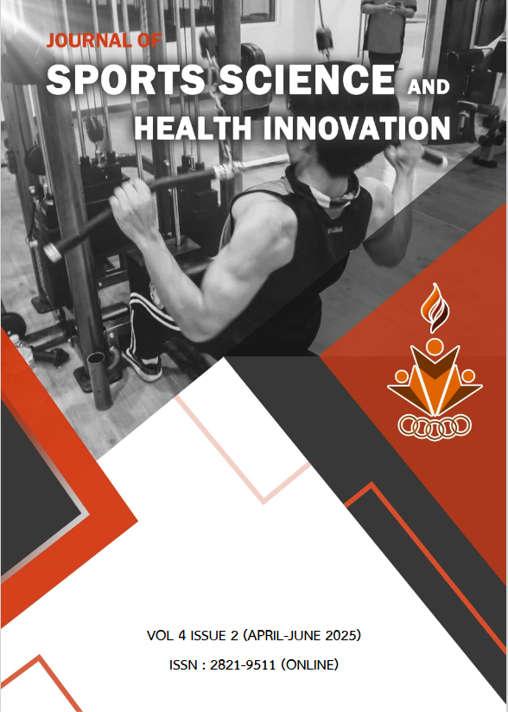A COMPARISON OF MUSCLE STRETCHING AND RELAXATION MASSAGE IN RELIEVING DELAYED ONSET MUSCLE SORENESS: A PILOT STUDY
Main Article Content
Abstract
This pilot study aims to compare the effects of muscle stretching and relaxation massage on relieving post-exercise muscle soreness. A total of 10 participants were randomly assigned into two groups: the first group received muscle stretching, while the second group received relaxation massage after performing an exercise protocol at 85% of 1-repetition maximum (1RM). Data were collected by measuring muscle soreness at three time points: immediately post-exercise, 24 hours post-exercise, and 48 hours post-exercise. The data were analyzed using mean, standard deviation, t-test, and repeated measures ANOVA. If significant differences were found, the Bonferroni post hoc test was used for pairwise comparisons, with statistical significance set at p < .05. The results indicated that relaxation massage significantly reduced muscle soreness in the short and medium term (p < .05), particularly at 24 and 48 hours post-exercise, compared to muscle stretching. Meanwhile, muscle stretching showed a tendency to provide better long-term benefits. However, the choice of recovery method should consider individual suitability and limitations. This study supports the use of relaxation massage as a primary strategy for short-term muscle soreness relief while recommending muscle stretching as a complementary approach for long-term muscle recovery and the continuation of exercise routines.
Article Details
เนื้อหาและข้อมูลในบทความที่ลงตีพิมพ์ในวารสารวิทยาศาสตร์การกีฬาและนวัตกรรมสุขภาพ กลุ่มมหาวิทยาลัยราชภัฏแห่งประเทศไทย ถือเป็นข้อคิดเห็นและความรับผิดชอบของผู้เขียนบทความโดยตรงซึ่งกองบรรณาธิการวารสาร ไม่จำเป็นต้องเห็นด้วย หรือร่วมรับผิดชอบใด ๆ
บทความ ข้อมูล เนื้อหา รูปภาพ ฯลฯ ที่ได้รับการตีพิมพ์ในวารสารวิทยาศาสตร์การกีฬาและนวัตกรรมสุขภาพ กลุ่มมหาวิทยาลัยราชภัฏแห่งประเทศไทย ถือเป็นลิขสิทธิ์ของคณะวิทยาศาสตร์และเทคโนโลยี มหาวิทยาลัยราชภัฏศรีสะเกษ หากบุคคลหรือหน่วยงานใดต้องการนำทั้งหมดหรือส่วนหนึ่งส่วนใดไปเผยแพร่ต่อหรือเพื่อกระทำการใด จะต้องได้รับอนุญาตเป็นลายลักษณ์อักษรจากวารสารวิทยาศาสตร์การกีฬาและนวัตกรรมสุขภาพ กลุ่มมหาวิทยาลัยราชภัฏแห่งประเทศไทย ก่อนเท่านั้น
References
Armstrong, R. A. (2014). When to use the Bonferroni correction. Ophthalmic & Physiological Optics, 34(5), 502-508. https://doi.org/10.1111/opo.12131
Cheatham, S. W., Stull, K. R., & Kolber, M. J. (2017). Comparison of two different foam rolling interventions on range of motion and pressure pain threshold: A randomized controlled trial. Journal of Bodywork and Movement Therapies, 21(4), 1014-1021. https://doi.org/10.1016/j.jbmt.2017.03.013
Cheung, R. T., Hume, P. A., & Maxwell, L. (2017). Delayed onset muscle soreness: Treatment strategies and performance
factors. Sports Medicine, 47(5), 837-856. https://doi.org/10.1007/s40279-017-0712-1
Cohen, J. (1992). A power primer. Psychological Bulletin, 112(1), 155-159. https://doi.org/10.1037/0033-2909.112.1.155
Damas, F., Nosaka, K., Libardi, C. A., Chen, T. C., & Ugrinowitsch, C. (2018). Susceptibility to muscle damage: A complex interaction between muscle function and structure. Sports Medicine - Open, 4(1), 1-12. https://doi.org/10.1186/s40798-018-0142-0
Dupuy, O., Douzi, W., Theurot, D., Bosquet, L., & Dugué, B. (2018). An evidence-based approach for choosing post-exercise recovery techniques to reduce markers of muscle damage, soreness, fatigue, and inflammation: A systematic review with meta-analysis. Frontiers in Physiology, 9, 403. https://doi.org/10.3389/fphys.2018.00403
Faul, F., Erdfelder, E., Buchner, A., & Lang, A. G. (2020). Statistical power analyses using G*Power 3.1: Tests for correlation and regression analyses. Behavior Research Methods, 39(2), 175-191. https://doi.org/10.3758/BF03193146
Herbert, R. D., de Noronha, M., & Kamper, S. J. (2011). Stretching to prevent or reduce muscle soreness after exercise. Cochrane Database of Systematic Reviews, 7, CD004577. https://doi.org/10.1002/14651858.CD004577.pub3
Hody, S., Croisier, J. L., Bury, T., Rogister, B., & Leprince, P. (2019). Eccentric muscle contractions: Risks and benefits. Frontiers in Physiology, 10, 536. https://doi.org/10.3389/fphys.2019.00536
Hohenauer, E., Taeymans, J., Baeyens, J. P., Clarys, P., & Clijsen, R. (2015). The effect of post-exercise cryotherapy on recovery characteristics: A systematic review and meta-analysis. Sports Medicine, 45(7), 1009-1024. https://doi.org/10.1007/s40279-015-0327-6
Jäger, R., Purpura, M., & Adams, A. (2017). Branched-chain amino acids and exercise performance: A review of the evidence. Nutrients, 9(7), 722. https://doi.org/10.3390/nu9070722
Konrad, A., Nakamura, M., Bernal, C., & Tilp, M. (2021). The chronic effects of static stretching on range of motion: A systematic review and meta-analysis. Sports Medicine, 51(1), 75-96. https://doi.org/10.1007/s40279-020-01313-4
Peake, J. M., Neubauer, O., Della Gatta, P. A., & Nosaka, K. (2017). Muscle damage and inflammation during recovery from exercise. Journal of Applied Physiology, 122(3), 559-570. https://doi.org/10.1152/japplphysiol.00971.2016
Poppendieck, W., Faiss, R., & Timpka, S. (2016). The effect of massage on delayed onset muscle soreness: A systematic review. International Journal of Sports Medicine, 37(12), 947-955. https://doi.org/10.1055/s-0042-108859
Thompson, W. R., Gordon, N. F., & Pescatello, L. S. (2020). ACSM's guidelines for exercise testing and prescription. Lippincott Williams & Wilkins.
Wiewelhove, T., Döweling, A., Schneider, C., Hottenrott, L., Meyer, T., Kellmann, M., & Ferrauti, A. (2019). A meta-analysis of the effects of foam rolling on performance and recovery. Frontiers in Physiology, 10, 376. https://doi.org/10.3389/fphys.2019.00376


